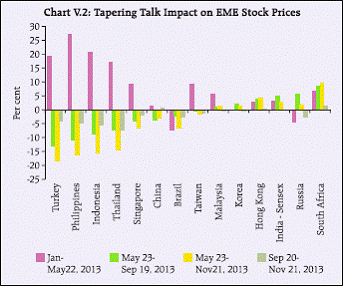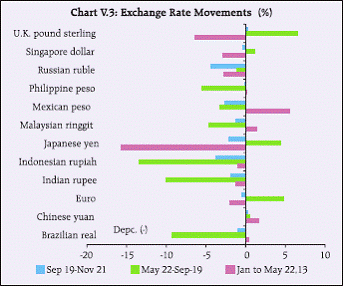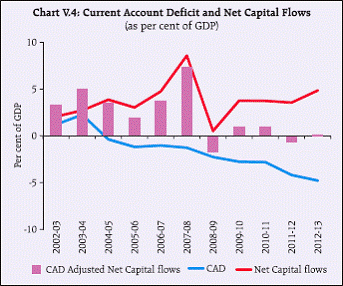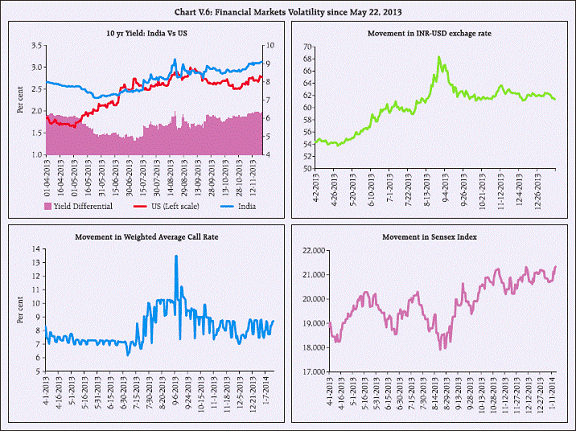1. Introduction
V.1 The conduct of monetary policy in a
globalised environment faces the challenge of
managing the impossible trinity1. It has become more
complicated by spillovers from monetary policies of
advanced economies in recent years. Announcement
effects of the exit from unconventional monetary
policies (UMPs) of systemically important central
banks have exposed the limits on the effectiveness
of monetary policy in spillovers-receiving economies.
Risk-on risk-off shifts in market perceptions have
imparted heightened volatility to cross-border
capital flows and to changes in asset prices
worldwide. Furthermore, because of hysteresis,
implications for the real economy (especially the
tradable sector) are not symmetric over phases of
inflows and outflows.
V. 2 Prior to the global crisis of 2008, there was an
apparent consensus that flexible exchange rates can
engender the space for independent conduct of
monetary policy, even if the capital account is open.
After the crisis, however, there is a clear intellectual
shift justifying a non-trivial role for capital flow
management (CFM) measures to mitigate the
externalities associated with global spillovers,
irrespective of the exchange rate regime, and for a
war-chest of international reserves as the first and
often, the only line of defence. Thus, the trilemma
has collapsed into a dilemma – independent monetary
policy is possible only if the capital account is
managed2,3.
V.3 The dominant influence of US monetary
policy on monetary policies of most EMEs has been
evident since the onset of the global crisis. Quantitative
easing (QE) led to the hardening of global commodity
prices which has been transmitted to EMEs in the
form of rising current account deficits (CADs) and
inflation. QE has also been a strong push factor driving
surges in capital flows into EMEs, causing their
exchange rates to appreciate and asset prices to
increase beyond levels regarded as tolerable hitherto.
QE-driven capital inflows, in fact, also helped
countries like India to meet the financing gaps opened
by sustained high CADs. Since May 2013, the effects
of ‘taper talk’ that became evident in sudden reversal
in debt capital flows and sharp depreciation of
exchange rates have added a whole new dimension
to the conduct of monetary policy in an interconnected
world. This warranted a re-think on (a)
degree of flexibility that monetary authorities need
to retain to manage large anticipated as well as
unanticipated globalisation induced shocks; and
(b) the armoury of instruments and the associated
costs in terms of achieving the final objectives of
monetary policy.
2. International Experience
V.4 Over the last decade, trade, finance and
sentiment channels have connected constituents of
the global economy more than ever before.
Repetitive episodes of crises have tended to focus
attention on the negative effects of this integration
relative to the gains. In particular, shocks emanating in AEs have amplified and prolonged risks to
monetary and financial conditions in EMEs, making
macroeconomic management for the latter a testing
challenge, especially in view of the large influence
of capital flows on macroeconomic fundamentals
(Table V.1)4.
2.1. Post-Global Crisis Country Experience on
Managing Surges in Capital Inflows
V.5 Faced with rapid inflows, Brazil imposed a
two per cent tax (Imposto de Operacoes Financeiras
or IOF) on portfolio (equity and debt) inflows in
October 2009 and subsequently raised it in phases to
six per cent (Appendix Table V.1). In addition, it also
raised unremunerated reserve requirements on time
deposits from 15 per cent to 20 per cent in December
2010. In January 2011, it imposed reserve requirements
on banks’ short dollar positions in the cash market.
However, anticipating a drop in foreign inflows once
the US taper takes hold, Brazil scrapped the IOF tax
in June 20135.
V.6 Similarly, Peru introduced a gamut of
measures during 2009-10. In July 2009, it enacted
variants of controls on capital inflows to stem
appreciation pressures (a ban on foreign purchases
of central bank bills and increased fees on central
bank liquidity draining instruments). In July 2010, it
implemented additional capital requirements for
forex credit risk exposure. Subsequently, in September,
it imposed increased reserve requirements (to 75 per
cent from 50 per cent earlier) on foreign currency
deposits with maturity of less than two years and
those on non-resident domestic currency deposits to
120 per cent (from 50 per cent earlier).
V.7 Indonesia introduced a one-month minimum
holding period requirement for central bank paper in
June 2010. In November 2010, reserve requirements
on local currency deposits were raised to eight per
cent (from six per cent earlier). Subsequently, in
December 2010, it raised the reserve requirements
on foreign currency deposits (from one per cent to eight per cent) and restricted short-term foreign
borrowings by banks (to 30 per cent of capital),
effective March 2011.
Table V.1: Impact of Capital Inflows on Macroeconomic Variables – Cross-country Comparisons |
Country |
Net inflows (% of GDP) |
Currency Movements (% change in NEER)# |
Change in reserves (% of GDP) |
Inflation (%: y-o-y) (average during 2006-08) |
Real credit growth (%: y-o-y) (average of last six months) |
Brazil |
6.2 |
38.4 |
6.0 |
5.0 (4.5) |
12.9 |
Indonesia |
2.6 |
19.4 |
7.4 |
6.2 (9.8) |
9.2 |
Korea |
1.9 |
17.5 |
10.7 |
3.3 (3.2) |
0.4 |
Peru |
5.9 |
5.6 |
9.0 |
2.1 (3.2) |
9.3 |
Thailand |
5.0 |
9.3 |
22.3 |
3.1 (4.1) |
4.3 |
Turkey |
6.9 |
6.5 |
1.7 |
7.9 (9.6) |
21.4 |
South Africa |
6.6 |
41.4 |
2.6 |
3.6 (6.4) |
-0.1 |
Czech Rep. |
5.3 * |
-0.8 $ |
-1.0 $ |
1.9 $ |
5.5 $ |
Poland |
9.2 ** |
15.3 $ |
0.9 $ |
4.3 $ |
13.9 $ |
Period: Q3:2009-Q2:2010 for the other countries; * Period: Q2:2009-Q1:2011; **Period: Q2:2009-Q2:2011
$ 2011 over 2010. #from the trough since the crisis
Source: IMF documents, country pages and central bank websites. |
V.8 In June 2010, Korea introduced ceilings on
forex forward positions of banks to lower leverage
and elongate banks’ funding structure. In January
2011, it re-introduced a 14 per cent withholding tax
on non-residents’ purchase of treasury bonds. In
August 2011, Korea also imposed a macro-prudential
levy on non-core liabilities, with the extent of the
levy being higher for non-core liabilities with shorter
remaining maturity.
V.9 Against the backdrop of high bond inflows,
Thailand announced the re-imposition of a withholding
tax on non-resident interest earnings and capital gains
in October 2010. Subsequently, in November 2010, it
announced a cap on loan-to-value (LTV) ratio for
residential property at 90 per cent on condominiums,
effective January 2011, and 95 per cent on low rises,
effective January 2012.
V.10 In December 2010, Turkey reduced the
withholding tax rate on bonds issued abroad by
Turkish firms, with lower rates for longer maturities.
Subsequently, it halted the practice of remunerating
required reserves, raised the levy on interest on
consumer loans and introduced LTV ratios for all
mortgages.
2.2. Country Experience on Managing Sudden
Capital Outflows
V.11 The Fed’s ‘taper’ announcement in May 2013
came as a major event shock for EMEs. As long-term
US treasury yields hardened significantly, there was
a huge sell-off in bonds all over the globe. Asian
markets came under intense pressure as the bond
sell-off was accompanied by flight of capital back into
the US. Bond yields firmed up across the globe
(Chart V.1). Countries that ran large CADs became
particularly vulnerable. Equity outflows followed, first
in portfolio and then in direct investment segments.
The subsequent announcement in September 2013
of deferment of the QE program moderated near-term
uncertainties to a large extent. Moreover, in recent
weeks, financial markets have been relatively calm
even as the taper started in January.
V.12 Despite limited headroom, EME central
banks have undertaken steps to counter stock
market slumps and sharp currency depreciation
(Charts V.2 and V.3). While some central banks (such
as in Brazil and Indonesia) responded in a
conventional manner by raising policy rates and
using foreign exchange reserves, others have
experimented with a range of unconventional policy measures. To illustrate, Brazil announced a US$ 60
billion currency intervention program in August
2013 involving swaps and repurchase agreements
with businesses requiring dollars6. Turkey’s central
bank is reported to have sold US$ 6-8 billion in
foreign currency auctions since June 2013.

 V.13 In June 2012, the BRICS initiated a plan to
establish a US$ 100 billion fund in order to steady
currency markets to address the potential fallout of
taper spillovers, with participating members being
able to draw a specified amount from the pool.
Furthermore, countries have undertaken proactive
measures towards rationalising non-essential imports
in order to shrink their CADs. In June 2013, Brazil
removed several capital controls, including taxes on
foreign portfolio investments that were introduced
in 2009. South Africa, in contrast, maintained an
eclectic approach, favouring a market-determined
exchange rate and maintaining an accommodative
monetary policy stance.7
V.14 Faced with sudden capital outflows and
adverse ramifications, several EMEs, including India,
had to temporarily alter their conduct of monetary
policy in addition to other measures. Some countries
used short-term interest rates as the first line of
defence, while others focused more on managing
liquidity. Some countries employed forex interventions
in the spot and/or the forward market, while others
relied more on forex swaps. Most countries resorted
to capital account management, using a combination
of measures to encourage capital inflows and
discourage or temporarily restrict capital outflows
(Appendix Table V.1).
V.15 From this experience, it appears that for
dealing with the challenges of globalisation-induced
shocks: (a) a wide array of tools is available to central
banks and the exact manner of using an instrument
could vary; (b) monetary measures may pursue
different objectives simultaneously in the face of large
and sustained spillovers without compromising the
medium-term goal of price stability; (c) forex swaps
can be a good short-run tool but their efficacy in the
long-run is constrained by difficulties in winding up
swap positions; and (d) forex intervention can give
some respite, particularly when reserves are perceived
to be adequate.
3. Indian Experience
V.16 In recent years, India has faced episodes of
surges in capital flows and sudden reversals and has
used a combination of exchange rate flexibility, capital
controls, monetary measures, macro-prudential tools
and reserves to manage them. Since 2002-03, India
has faced four broad phases of volatile capital
movements, each requiring different monetary policy responses8 (Chart V.4). During 2003-2007, capital
inflows were a major challenge for monetary policy.
Coinciding with the global crisis of 2008, capital
outflows and exchange market pressures necessitated
unprecedented monetary easing to avert a financial
crisis and support a sluggish economy. In the years
immediately after the global crisis, QE-induced capital
flows helped to finance large current account deficits
over successive quarters from Q2:2009 to Q1:2013,
but without accretion to reserves and with rising
external liabilities (against the backdrop of an
appreciating exchange rate in real terms). More
recently, sudden and large outflows in response to
taper talk since May 2013 required monetary policy
to respond directly to exchange market pressures,
including through the use of exceptional measures.
 3.1. Monetary Policy Response to Surges in Capital
Inflows
V.17 Over the period 2003-04 to 2006-07, high
growth operated as a ‘pull’ factor for surges in capital inflows, with easy global liquidity conditions
providing the key ‘push’. Large inflows in excess of
the absorptive capacity of the economy created
concerns about erosion in external competitiveness
through exchange rate appreciation, possible
overheating of the economy and asset price bubbles,
besides the growing risk of an abrupt reversal.
V.18 In response, a multi-pronged approach was
followed which included, inter alia , phased
liberalisation of current as well as capital account
outflows; exchange market intervention and partial
sterilisation; lowering of interest rate ceilings on NRI
deposits; management of external debt through prepayment;
moderation in the access of corporates and
intermediaries to external debt; and greater flexibility
in exchange rate movements.
V.19 Sterilising the liquidity impact of sustained
accretions to reserves was the key monetary policy
challenge, and a combination of higher CRR, reverse
repos and open market operations under the Market
Stabilisation Scheme (MSS)9 alongside some exchange
rate appreciation was used for this purpose, which
facilitated distribution of sterilisation costs across the
financial system, the Reserve Bank and the Government
(Chart V.5).
V.20 Reverse repos and outright OMO sales
demanded the availability of adequate stock of
government securities with the RBI, which became a
constraining factor in sterilisation operations as the
volume of capital inflows expanded. Moreover,
reverse repo operations involved sterilisation costs,
impacting the profit of the RBI, with implications for
RBI’s operational independence. Using the LAF as an instrument of sterilisation tended to erode its utility
as a day-to-day liquidity adjustment tool operating at
the margin (RBI, 2003)10. It was in this context that
the RBI introduced MSS11. As the subsequent
experience showed, the MSS brought with it
operational constraints that impacted the conduct of
sterilisation.12
3.2. Monetary Policy Response to Inadequate Capital
Inflows/ Sudden Capital Outflows
V.21 Three episodes of drying up of capital and/or
reversals are discernible in the recent experience.
First, during the Asian crisis and sanctions applied
after the Pokhran nuclear tests, i.e., 1997 and 1998,
the Indian rupee came under several bouts of
pressure. Besides interventions in the spot and the
forward segments of the forex market, monetary
policy measures were used to tighten domestic
liquidity and monetary conditions (Appendix Table V.2). In August 1998, the scheme of Resurgent India
Bonds (RIBs) was launched to attract capital flows from
the non-resident Indian diaspora.
V.22 Second, the knock-on effects of the global
financial crisis required pre-emptive crisis prevention
measures, primarily in the form of adequate assurance
on making available both rupee and US dollar liquidity
in the domestic markets. Despite exchange market
pressures associated with capital outflows, interest
rate defence of the exchange rate was not resorted to
in view of the risks to financial stability and growth.
Moreover, there was a significant moderation in WPI
inflation after the global financial crisis, which was
partly the result of the crisis-driven crash in global
commodity prices. Unprecedented monetary easing
over a short time span was the chosen response,
facilitated by the headroom created by the gradual
withdrawal of monetary accommodation from
September 2004 to August 2008 in response to
inflation. With reverse repos, OMO sales, CRR cuts,
unwinding of MSS balances and the opening up of
special liquidity windows and lines of credit to apex
refinancing institutions, the potential access to
liquidity from the RBI was as high as around 10 per
cent of GDP.
V.23 Third, the large depreciation of the rupee
after May 22, 2013 – one of the highest among major
EME currencies – required actions on multiple fronts,
driven by the urgency of curbing speculative
pressures on the exchange rate, narrowing the CAD
and finding exceptional external financing. Taperdriven
capital outflows – primarily in the form of
debt portfolio flows – narrowed the spread between the G-sec yield and US Treasury yield significantly;
the subsequent increase in money market interest
rates and G-sec yields in response to monetary policy
actions contributed to expectations of further
depreciation, driven by uncovered interest rate parity
conditions (Chart V.6, Appendix Tables V.3 and V.4).
V.24 In sum, the Indian experience in managing
the challenges of two-way capital flows over different
phases suggests that: (a) monetary measures address
spillovers only indirectly, and are contingent on their
impact on the growth and inflation outlook, but
monetary measures occasionally have to respond
directly to the disruptive impact of capital flows on
financial markets; (b) the capacity of the RBI to
sterilise/manage the domestic liquidity impact of net
forex market interventions would have to be augmented significantly in respect of both inflows
and outflows; (c) text book interest rate defence of
the exchange rate will have to be an instrument of
the first resort in order to “buy” time, but its use and
sustainability has to be conditioned by the assessment
of costs to the economy from rising interest rates and
financial stability considerations; (d) if an external
event entails the risk of a global recession which can
dampen domestic growth prospects and raise financial
stability concerns, preparedness for a swift monetary
easing may be necessary, even if the exchange rate
comes under pressure without compromising the
medium-term goal of price stability; and (e) if the
foreign exchange reserves are not perceived to be
adequate, monetary measures to avert a free fall in
the exchange rate may not be very effective. In these conditions the risks of a failed monetary defence of
the exchange rate may get heightened into snowballing
consequences propelled by unidirectional expectations
and herding.
 Recommendations
V.25 In view of the cross country and Indian
experience with global spillovers driving episodes of
large and volatile capital inflows as well as outflows,
a flexible setting of monetary policy by the RBI in the
short-run is warranted. This presages readiness to use
a range of instruments at its command, allowing
flexibility in the determination of the exchange rate
while managing volatility through capital flow
management (CFM) and macro-prudential measures
(including sector specific reserve requirements)
V.26 With regard to inflows that are excessive in
relation to external financing requirements and the
need for sterilised intervention: (a) the RBI should
build a sterilisation reserve out of its existing and
evolving portfolio of GoI securities across the range
of maturities, but accentuated towards a ‘strike
capability’ to rapidly intervene at the short end; and
(b) the RBI should introduce a remunerated standing
deposit facility, as recommended in Chapter-III, which
will effectively empower it with unlimited sterilisation
capability.
V.27 As a buffer against outflows, the RBI’s strategy
should be to build an adequate level of foreign
exchange reserves, adequacy being determined not
only in terms of its existing metrics but also in terms
of intervention requirements set by past experience
with external shocks and a detailed assessment of tail
events that materialised in the country experiences.
As a second line of defence, swap arrangements,
including with regional financing initiatives, should
be actively pursued. While retaining the flexibility to
undertake unconventional monetary policy measures
as demonstrated in response to announcement effects
of QE taper but with clarity in communication and
better co-ordination, the Committee recommends that
the RBI should respond primarily through conventional
policy measures so as to ensure common set of shared
expectations between the markets and the RBI, and
to avoid the risk of ‘falling behind the curve’
subsequently when the exceptional measures are
unwound.
V.28 In addition to the above, the RBI should
engage proactively in the development of vibrant
financial market segments, including those that are
missing in the spectrum, with regulatory initiatives
that create depth and instruments, so that risks are
priced, hedged, and managed onshore.
|